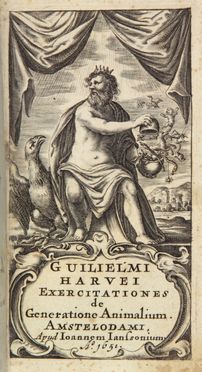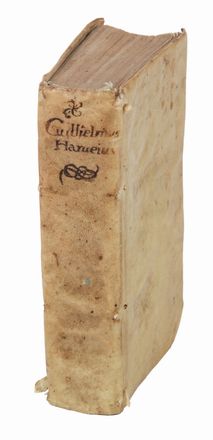Auction 13 / Manuscripts, Incunabula, Autographs and Printed Books
fri 25 OCTOBER - sat 26 OCTOBER 2013
Lot 525
Harvey William
Zoologia, Scienze naturali
Exercitationes de generatione animalium. Quibus accedunt quaedam De partu: de Membranis ac humoribus Uteri & de conceptione.
Amstelodami: Apud Joannem Janssonium, 1651.
In-12° (mm 133x73). Pagine [36], l'ultima bianca, 415, [1] bianca, [4]. Frontespizio calcografico, capilettera e testatine incise in legno. Lavoro di tarlo nel margine interno delle carte del fascicolo )()(, per il resto buon esemplare. Legatura coeva in piena pergamena semi-rigida con titoli manoscritti al dorso e lacerti di legacci. Ex-libris Giuseppe Franchini stampato alla carta di sguardia posteriore.
Una delle tre edizioni di Amsterdam, uscite nello stesso anno della prima; queste edizioni hanno in più rispetto a quella londinese un secondo frontespizio, inciso in rame. L'opera si compone di una prefazione e di 72 Exercitationes numerate più molte non numerate. Cfr. Heirs of Hippocrates 436: «After the publication of De motu cordis, Harvey turned his attention to the study of generation. Even if Harvey had not discovered the circulation of the blood, his remarkable work on embryology would have placed him in the front ranks of biological scientists. Without benefit of the compound microscope, his work was necessarily limited; nevertheless, nothing comparable had been done since Aristotle. He disbelieved the previously-held doctrine of "preformation" of the fetus, maintaining instead that it proceeds from the ovum by gradual building up of its parts. Always slow to publicize his findings, Harvey was only after some years persuaded by his friend, Sir George Ent, to put them into print»; Osler 711; Russell 376; Walleriana 4119; Welcome III, 220.













